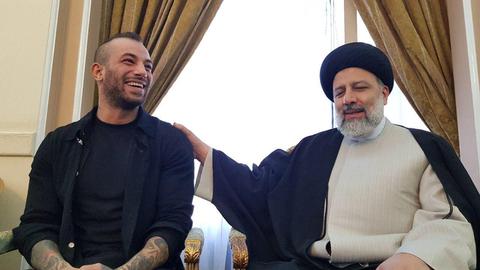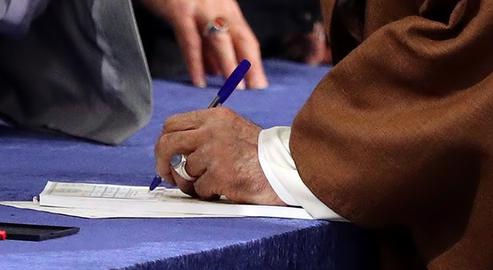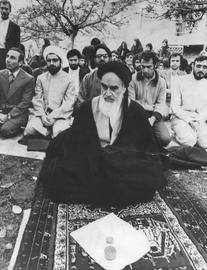So, now that's it's over, let's take a little journey through the five most bizarre moments of the election...
1. Daughter of Education Minister in “Smuggling” Scandal
During the second presidential debate on May 7, Mohammad Bagher Ghalibaf became obsessed with proving that President Rouhani’s government was steeped in corruption. To this end, he accused the daughter of Rouhani’s education minister of smuggling clothing into Iran. His source? A murky report penned by the judiciary that revealed “imported clothing” had been discovered in a villa in northern Tehran.
Vice President Eshagh Jahangiri, who was running as a “backup” candidate for Rouhani, correctly pointed out that the charges against the minister’s daughter had been dropped and she had paid all custom duties. But his response, correct as it was, was not very politically correct. It left the impression that at least some people in Rouhani’s government were taking advantage of their position and benefitting financially, even though they might not have actually broken the letter of the law.
Fakhreddin Ahmadi-Danesh-Ashtiani, the education minister, offered to appear on TV and set the record straight, but, fortunately for Rouhani, he did not need to do this. The story was mostly forgotten after that, pushed out of the limelight by other news. Nonetheless, Rouhani and Jahangiri's campaign teams had to waste a whole week deciding how to address the tirades fuelled by Ghalibaf’s accusation.
2. Khamenei Scraps Education Scheme
Ayatollah Khamenei introduced this particular distraction to the campaign. Officials endorsed UNESCO’s Education 2030 Framework for Action — also known as the Incheon Declaration — in May 2015. It aims to “ensure inclusive and equitable quality education and promote lifelong learning opportunities for all.”
But on May 7 — the same day of the second presidential debate and when the smuggling accusations against the education minister’s daughter emerged — Ayatollah Khamenei announced that Iran refused to submit to agendas “like UNESCO 2030.” And he wanted to know: “Why should a so-called international community — which is definitely infiltrated by the corrupt powers — have the right to make decisions for the various cultures among nations?”
During the presidential debates, Rouhani’s rivals Ghalibaf and Ebrahim Raeesi chose to largely ignore this bizarre development, but little by little, it was revealed that their campaigns were using the issue actively when campaigning in religious and rural areas. They told people that if and when this framework was implemented, their children would receive sex education from the second grade of primary school, that teaching the Koran would have to stop, and that children would be forced to accept the legitimacy of homosexuality.
Not only did some cabinet ministers and government spokesmen have to speak out about the issue, but Rouhani and Jahangiri had to personally spend a huge amount of time trying to neutralize the propaganda. Even up until the last minute before the campaigning cut-off point — midnight on Wednesday, May 17 — the government was issuing statements about it. As a campaign ploy, it was rather effective, as it forced Rouhani and Jahangiri to waste a significant amount of time.
3. The Odd Couple: Raeesi Meets the R&B Singer
Nobody could have imagined that a meeting between a singer and Iran’s conservative candidate would turn out to be one of the most talked-about events leading up to the election.
Amir Hossein Maghsoudlou, known by his stage name Amir Tataloo, has been dubbed the “father of rhythm and blues” in Iran. Needless to say, the conservatives are not huge fans. He has been arrested more than once and his songs are not broadcast on state-run radio or TV. But, surprisingly, he is good friends with the Revolutionary Guards. In fact, after the nuclear agreement went into effect in 2015, they helped him create a video emphasizing Iran’s right to “self-defense.”
After the approved list of presidential candidates was announced, Tataloo started posting on social networks, saying he was quoting unnamed Revolutionary Guards intelligence agents. Officially, Iranian law does not allow the military to interfere in elections, but apparently the Guards decided that Tataloo was a convenient and popular way to dodge the law. What he posted agreed with the conservatives’ views and policies, and was also used to support Mohammad Bagher Ghalibaf and, later, Ebrahim Raeesi.
But people didn't expect Raeesi and Tataloo to actually meet. Not only did the meeting happen, it was widely publicized — and then, Tataloo’s songs were played at campaign gatherings and events, turning a “symbol of corruption” into a propaganda tool for the principlist conservative Raeesi.
Tataloo has a huge following, so some people say Raeesi owes him four million votes. At the same time, it’s hard to know how many millions of votes it cost him, because many people who consider themselves to be loyal to the values of the Islamic Republic never changed their mind about Tataloo. For them, he was still a symbol of decadent western culture. As the election approched, explaining the Tataloo anomaly took up a lot of Raeesi's supporters’ time. It's not even clear that the controversy will die away or the wounds will heal anytime soon.
4. The Supreme Leader’s Ring
Who could have thought the color of Ayatollah Khamenei’s agate ring would become an election directive? On the morning of Friday, May 19, just after the polls opened, the Supreme Leader of the Islamic Republic cast his well-publicized vote. People posted photographs of him voting on Instagram, and there it was: His violet-tinted agate ring. Many commented that the color indicated that Khamenei wanted Rouhani to win —purple was the color of the president’s campaign. It got to a point where Khamenei’s office was forced to officially deny the claim but, as things usually go in Iran, most people did not believe or accept these denials, and some even posted that they had been undecided before seeing this photograph. When they saw the purple ring, they made their decision: they must vote for Rouhani.
5. Instagram vs. Telegram
Some people said Telegram transformed the election, with one IranWire writer asking if it could change Iran. Yes, the Telegram app played an important role in the 2017 Iranian election, but it had a serious competitor: Instagram. Because Instagram is built around photographs and images — an altogether more pleasant, attractive and direct way to share information — it also did its part. For some people at least, a picture is worth a thousand words. With Instagram, the Iranian electorate didn’t need to say anything. And on occasion, Instagram stole the show, even rivalling Iran's state-run TV.
visit the accountability section
In this section of Iran Wire, you can contact the officials and launch your campaign for various problems


























comments